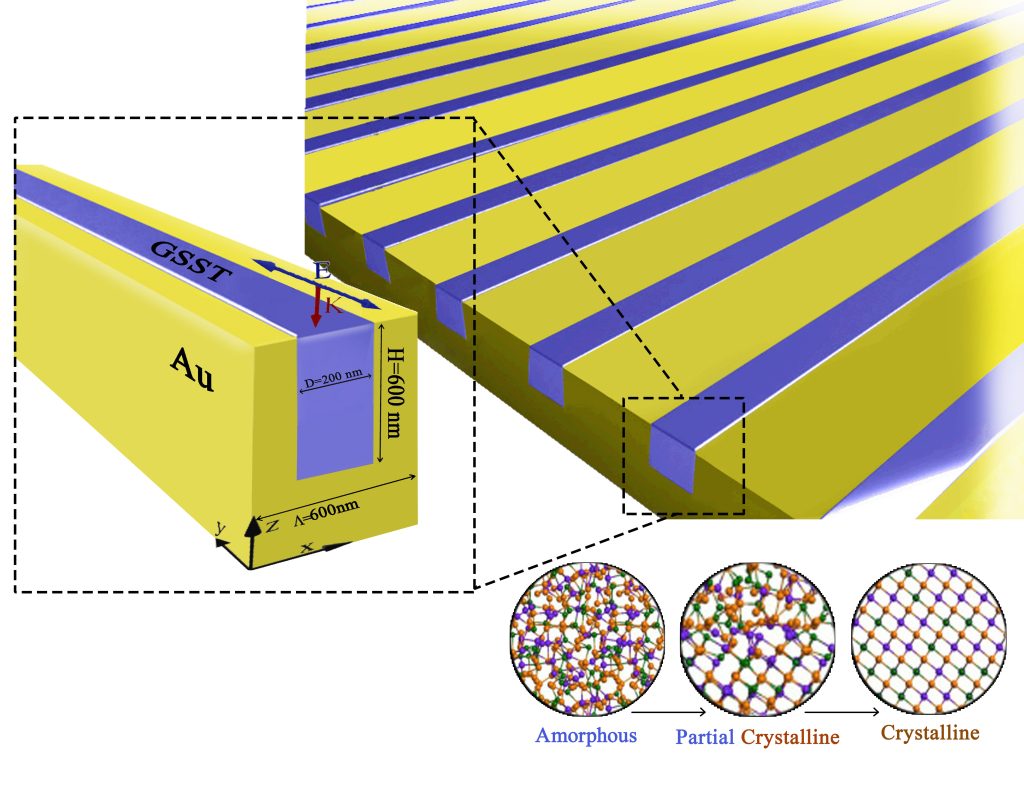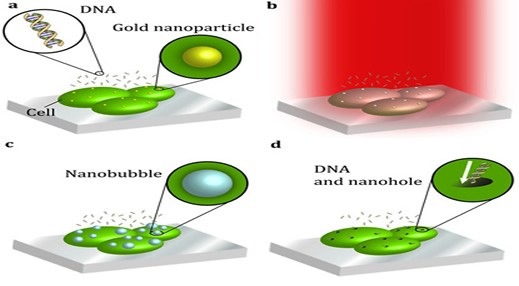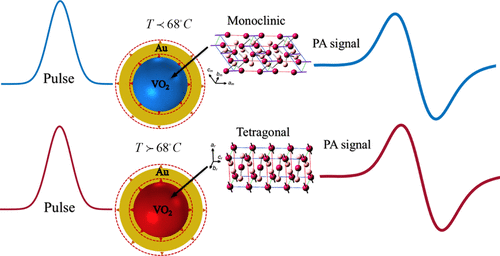The following are some specific research topics :
- Photo thermal induced reconfigurability in volatile and non-volatile nanostructures using phase change material: Recently, phase change materials (PCM) have garnered significant attention in the fabrication of highly tunable active non-volatile and volatile nanostructures. This is attributed to their remarkable variation in refractive index when they undergo phase transition between two extreme states. External electrical, optical, or thermal excitations can trigger the phase transition in these materials. By incorporating PCMs into conventional photonic devices, their optical response can be tuned without altering their structural properties. In our research group, each PCM-based project aims to explore photonic devices hybridized with PCMs and comprehensively study the changes in various quantities during the PCM’s phase transition. These projects not only introduce promising platforms in the field of photonics but also provide team members with valuable opportunities to develop fundamental and computational skills in the field.

- Plasmonic enhanced short and ultrashort laser interactions with nanostructures for biomediacal applications:Enhanced by the presence of gold nanostructures (AuNPs), the femtosecond (fs) laser field will first heat the conduction electrons of the AuNPs and then produce a transient and non-stationary thermal field with highly localized plasma in the biological medium surrounding the AuNPs. This plasma relaxes rapidly through electron-ion interaction and releases a pressure wave, leading eventually to a phase transformation and the generation of a short-lived vapor nanobubble around the particle. The effect of the transient bubble on cells induces a shear stress during bubble expansion that disrupts the cell membrane. This local induced disruption in the cell membrane allows the exchange of cellular material with the medium. In this process, a precise control of the heat energy absorption by plasma and its dissipation to the surrounding cellular medium will optimize the mechanical, thermal and optical bubble parameters operating on the nanoscale, to avoid any fragmentation or death of the targeted cells. This new technique is expected to have minimal undesirable tissue interactions, high selectivity, and is a very promising and efficient, high throughput, virus-free method that could have future in vivo applications.

- Quantum dot-plasmonics nanostructure hybrid nanosensors : Significant research efforts have focused on the investigation of fluorescent nanosensors for optical detection of single chemical and biological molecules with ultra-high sensitivities. To overcome their current limitations related to background interference, scattering properties of the sample or non-absorbing probe light, quantum dots (QDs)-based fluorescent sensors have attracted considerable interest. We propose to introduce a new generation of nanosensors based on fundamentally new physics consisting of a QD and AuNP hybrid system. Previous investigations have shown that fluorescence resonance energy transfer between QDs and AuNPs induced by a fs pulse laser field (coherent exciton-plasmon coupling) supports a bistability in the QD-AuNP hybrid system, referred to as bright and dark states based on photoluminescence enhancement and suppression of QDs. The balance between these two stable states can be controlled by the nature and geometry of QD-AuNP as well as the local refractive index.

- Photoacoustic (PA) response from metallic nanostructures irradiated by a pulsed laser for radiotherapy applications: PA imaging of AuNPs contrast agents is a powerful non-invasive imaging method with high contrast and micron-scale resolution. In this technique, pulsed laser light is absorbed by AuNPs and converted into an outgoing thermoacoustic wave. This wave can be detected by an ultrasound transducer and used to reconstruct images. Inspired by recent developments in ultra-high-frequency wide-bandwidth transducers, we propose a project to develop a solid theoretical understanding of PA imaging using an fs pulsed laser to irradiate a region of interest. We introduce a new approach to significantly increase the contrast-to-noise ratio of contrast-enhanced AuNP-augmented imaging by optimizing the optical-to-acoustic conversion (optoacoustic) efficiency. In this research, proper control of the absorption-to-scattering coefficient on the designed nanostructure will play a key role in achieving the desired results.

-
Plasmonic photovoltanic: The growing global demand for energy and increasing pressure to develop new sources of clean and renewable energy is driving the search for new photovoltaic devices capable of harnessing solar energy efficiently. A significant cost reduction is needed to make power from photovoltaics competitive with fossil-fuel technologies. Since most of the cost is due to the prices of materials and processing, there is great interest in ultra thin-film solar cells. Unfortunately, a smaller thickness of the active layer results in less absorbed light and lower efficiency of these devices. Plasmonic nanostructures can localize incident light on a sub-micrometric scale enabling light concentration and trapping. Engaging the active layer with these nanostructures is of the most promising ways to offer enhance light trapping, permitting a considerable reduction in the physical thickness of solar photovoltaic absorber layers, and yielding new options for solar cell design. However, a precise engineering is needed to limit losses by optical absorption in plasmonic nanostructures over the entire solar spectral. In this project is offering an optimized model for a hybrid tandem plasmonic photovoltaic solar cell. This model uses the plasmonic nanostructures in the form nanoparticles as omnidirectional scattering centers and corrugated metallic film backreflectors as guiding modes. In this project all the optimizations will be based on modeling both the electronics and optics of the proposed photovoltaic devices. We will extend the use of optoelectronic modeling to optimize further our metallic nanosturctures and structured electrode designs to achive maximum absorption enhancement by the active layer.
